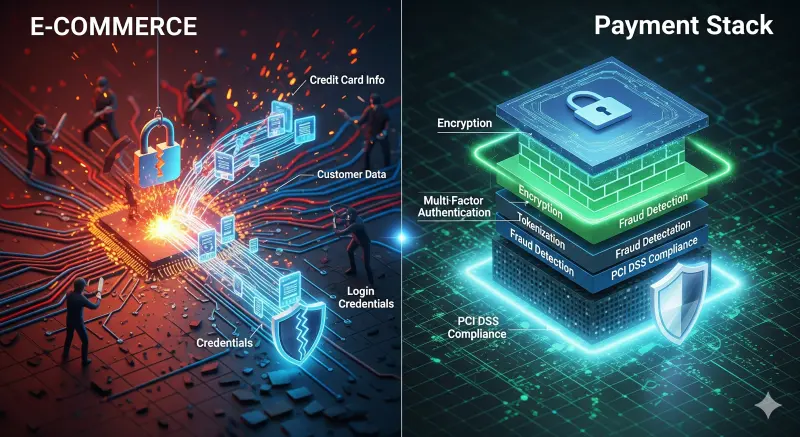Elite Webstores Team
AI in Payments: Revolutionizing Fraud Prevention and Personalization for Online Stores
1 in 5 declined transactions in 2024 was a false positive. AI-driven risk + tailored checkout can turn those into rescued revenue.
AI has moved from buzzword to baseline in payments. The winners: merchants who embed adaptive risk models + real-time personalization at the checkout layer while keeping governance & customer trust intact.
Why AI Now?
- Massive behavioral + device telemetry streams (PSPs + browser + device fingerprinting)
- Mature ML tooling (fraud graph networks, vector similarity search, feature stores)
- Escalating attack sophistication (bot farms, synthetic identities, refund abuse)
- Regulatory pressure (SCA, AML, DSA) pushing smarter, friction-calibrated flows
Core AI Use Cases
| Domain | AI Capability | Outcome | Typical Lift |
|---|---|---|---|
| Fraud Scoring | Real-time feature engineered models | Fewer false declines | +20–40 bps auth |
| Bot Defense | Behavioral sequence modeling | Blocks scripted attacks | -60% fake attempts |
| Account Takeover | Login anomaly graphing | Early credential theft detection | -35% ATO loss |
| Adaptive SCA | Risk-tiered challenge triggering | Less friction | -8–12% cart drop |
| Personal Pricing/Offers | Segmented LTV propensity models | Higher AOV | +5–12% AOV |
| Retry/Routing | Predictive success modeling | Higher acceptance | +30–80 bps auth |
| Chargeback Triage | NLP on dispute narratives | Faster representment | -15% OpEx |
Balanced with narrative: The table gives the landscape; below is how to operationalize.
Architecture Pattern (Merchant POV)
- Event Capture: payment intents, 3DS outcomes, device signals, velocity counters.
- Feature Layer: rolling transaction counts, BIN risk labels, geo mismatch ratios.
- Model Layer: fraud classifier (GBM / transformer hybrid), routing uplift model.
- Decision API: synchronous (<120ms budget) for checkout risk; async enrichment pipeline.
- Feedback Loop: chargeback / refund / manual review outcomes streamed back.
- Governance: versioned model registry + explainability logging.
PSP Integration Angles
| PSP | Native AI Components | Where You Extend | Quick Win |
|---|---|---|---|
| Stripe | Radar rules + ML, adaptive 3DS | Custom event features via webhooks | Tune rule thresholds by segment |
| Checkout.com | Risk engine + routing optimization | Inject merchant risk scores pre-auth | Blend geos across acquirers |
| PayPal | Buyer risk scoring, dispute tooling | Layer A/B tailored checkout UI | Reduce false declines on returning users |
| Worldpay | Fraud screening + monitoring | Add behavior enrichment + 2nd look model | Salvage soft declines via retries |
Personalization Without Creeping Users
- Progressive enhancement: start with payment method ordering, not price discrimination.
- Transparency: explain why extra step (3DS / document) was triggered.
- Guardrails: never personalize in ways that alter tax, legal compliance, or fairness.
- Privacy Layer: minimize PII; favor pseudonymous IDs + consent-tagged attributes.
Predictive Metrics to Track
| KPI | Definition | AI Influence |
|---|---|---|
| False Positive Rate | Legitimate orders blocked / total legit | Primary reduction target |
| Incremental Auth Lift | Auth rate vs control | Measures routing + risk synergy |
| Friction Rate | % checkouts w/ challenge (3DS / step-up) | Optimize downward for low-risk cohorts |
| Conversion Recovery | Rescued orders / initial declines | Shows retry + soft decline salvage |
| ATO Incident MTTR | Mean time to remediate | Faster anomaly surfacing |
Implementation Phases
0–30 Days: Instrument events + central risk datastore. Baseline metrics. 30–60 Days: Deploy vendor risk (PSP native) + lightweight custom features. 60–120 Days: Train bespoke fraud + personalization models; A/B rule sets. 120–180 Days: Introduce adaptive SCA + dynamic routing uplift. 180d+: Continuous model retraining + governance dashboards.
Ethical & Regulatory Considerations
- Bias Audits: monitor approval disparities across protected attributes (proxy analysis).
- Explainability: retain top feature attributions for adverse decisions.
- Data Retention: align with GDPR minimization; age out stale features.
- Human-in-Loop: sample borderline scores for analyst adjudication.
ROI Framing (Board Slide)
Narrative: We cut false declines by 25%, increased net auth 40 bps, and lifted AOV 7% via tailored payment method ordering. Net effect: +3.2% revenue on same traffic within 6 months.
Quick Checklist
- Unified event + feature schema
- PSP webhook ingestion live
- Baseline auth + false decline metrics stored
- Model latency under 120ms P95
- Governance log (model + version + hash)
- Bias monitoring scheduled
Where Elite Webstores Helps
We design risk + personalization pipelines, unify multi-PSP events, and operationalize decision APIs that respect compliance while driving conversion.
Want to explore AI payment uplift? Talk to us or review Services.
Ready to turn static checkout into a learning system? Start the conversation →



